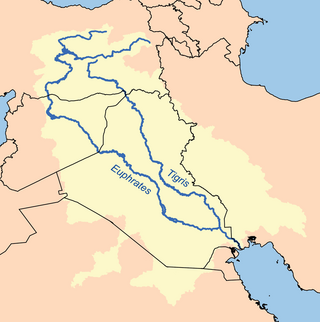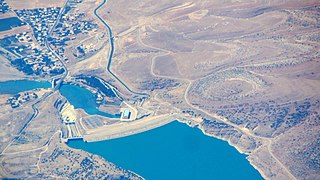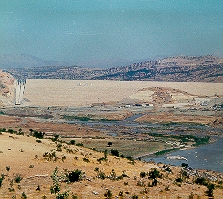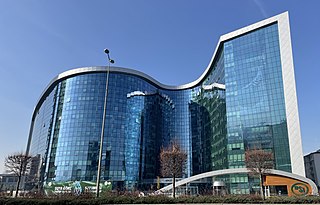
The Euphrates is the longest and one of the most historically important rivers of Western Asia. Together with the Tigris, it is one of the two defining rivers of Mesopotamia. Originating in Turkey, the Euphrates flows through Syria and Iraq to join the Tigris in the Shatt al-Arab in Iraq, which empties into the Persian Gulf.

The Tigris is the eastern of the two great rivers that define Mesopotamia, the other being the Euphrates. The river flows south from the mountains of the Armenian Highlands through the Syrian and Arabian Deserts, before merging with the Euphrates and reaching to the Persian Gulf.

The Tigris–Euphrates river system is a large river system in Western Asia that flows into the Persian Gulf. Its primary rivers are the Tigris and Euphrates, along with smaller tributaries.

Hydroelectricity, or hydroelectric power, is electricity generated from hydropower. Hydropower supplies 14% of the world's electricity, almost 4,210 TWh in 2023, which is more than all other renewable sources combined and also more than nuclear power. Hydropower can provide large amounts of low-carbon electricity on demand, making it a key element for creating secure and clean electricity supply systems. A hydroelectric power station that has a dam and reservoir is a flexible source, since the amount of electricity produced can be increased or decreased in seconds or minutes in response to varying electricity demand. Once a hydroelectric complex is constructed, it produces no direct waste, and almost always emits considerably less greenhouse gas than fossil fuel-powered energy plants. However, when constructed in lowland rainforest areas, where part of the forest is inundated, substantial amounts of greenhouse gases may be emitted.
The Atatürk Dam, originally the Karababa Dam, is the third largest dam in the world and it is a zoned rock-fill dam with a central core on the Euphrates River on the border of Adıyaman Province and Şanlıurfa Province in the Southeastern Anatolia Region of Turkey. Built both to generate electricity and to irrigate the plains in the region, it was renamed in honour of Mustafa Kemal Atatürk (1881–1938), the founder of the Turkish Republic. The construction began in 1983 and was completed in 1990. The dam and the hydroelectric power plant, which went into service after the upfilling of the reservoir was completed in 1992, are operated by the State Hydraulic Works (DSİ). The reservoir created behind the dam, called Atatürk Reservoir, is the third largest in Turkey.
The Southeastern Anatolia Project is a multi-sector integrated regional development project based on the concept of sustainable development for the 9 million people (2023) living in the Southeastern Anatolia region of Turkey. According to the Southeastern Anatolia Project Regional Development Administration, the aim of the GAP is to eliminate regional development disparities by raising incomes and living standards and to contribute to the national development targets of social stability and economic growth by enhancing the productive and employment generating capacity of the rural sector.The Southeastern Anatolia Region extending over wide plains in the Euphrates-Tigris Basin encompass the administrative provinces of which are located in the basins of the Euphrates and Tigris and in Upper Mesopotamia. The surface area of the region bordering with Syria to the south and with Iraq to the southeast is 75,193 square kilometres which corresponds to 9.7% of Turkey’s total surface area. Turkey has in total 8.5 million hectares of irrigable land and GAP’s share in this total is 20 per cent.The total cost of the project is over 190 billion Turkish lira (TL).

Batman Dam is one of the 22 dams of the Southeastern Anatolia Project of Turkey, built on the Batman River, north of Batman, in southeastern of Turkey. It was constructed between 1986 and 1999. There is a hydroelectric power plant, established in 1998, at the dam, with a power output of 191.7 MW. The dam is designed to service an irrigation area of 37,744 ha. The Silvan Dam is located upstream.

Dicle Dam is one of the 21 dams of the Southeastern Anatolia Project of Turkey. These facilities are located within the provincial territory of Diyarbakır, at a distance of 50 kilometres to Diyarbakır city centre. More specifically, the dam and the hydroelectric power plant are located in Eğil district, at a distance of 800 metres from the point of junction of the streams of Maden Stream and Dibni to form the Tigris, and 22 kilometres downstream of the Kralkızı Dam. Construction works were started in 1986 and the dam was completed in 1997. The dam has an installed hydroelectric capacity of 110 MW and is designed to ultimately irrigate 128,080 hectares. In 2001 a water transmission line and a water treatment plant were commissioned that provided about 85% of the drinking water for the city of Diyarbakir in 2010. In 2018 a gate of the dam broke the water lever decreased and a part of a village re-emerged in the Eğil district.

Kralkızı Dam is one of the 21 dams of the Southeastern Anatolia Project of Turkey in Batman. The hydroelectric power plant has a total installed power capacity of 94 MW. The dam was constructed between 1985 and 1997.

The Ilısu Dam is a concrete-face rock-fill dam on the Tigris near the village of Ilısu and along the border of Mardin and Şırnak Provinces in Turkey. It is one of the 22 dams of the Southeastern Anatolia Project and its purpose is hydroelectric power production, flood control and water storage. When operational, the dam will support a 1,200 MW power station and will form a 10.4 billion m3 reservoir. Construction of the dam began in 2006 and was originally expected to be completed by 2016. As part of the project, the much smaller Cizre Dam is to be constructed downstream for irrigation and power. The dam has drawn international controversy, because it will flood portions of ancient Hasankeyf and necessitate the relocation of people living in the region. Because of this, the dam lost international funding in 2008. Most historical structures in Hasankeyf were moved to the new Hasankeyf prior to the filling of the dam. The dam began to fill its reservoir in late July 2019. Due to rainfall, the dam has achieved water levels up to 100m above the river bed and stored 5 billion cubic meters of water. The water level had reached an elevation of 498.2m on 1 April 2020.
Silvan Dam is an embankment concrete-face rock-fill currently under construction on the Batman River in the district of Silvan, Diyarbakır Province in southeastern Turkey. It is part of the Southeastern Anatolia Project and located upstream of the Batman Dam. Construction began on 26 July 2011. The purpose of the dam is hydroelectric power production and irrigation. It is designed to irrigate an area of 245,000 ha. The power station will have an installed capacity of 160 MW.

Mosul Dam, formerly known as Saddam Dam, is the largest dam in Iraq. It is located on the Tigris river in the western governorate of Nineveh, upstream of the city of Mosul. The dam serves to generate hydroelectricity and provide water for downstream irrigation. At full capacity, the structure holds about 11.1 cubic kilometres (2.7 cu mi) of water and provides electricity to the 1.7 million residents of Mosul.

Water conflict typically refers to violence or disputes associated with access to, or control of, water resources, or the use of water or water systems as weapons or casualties of conflicts. The term water war is colloquially used in media for some disputes over water, and often is more limited to describing a conflict between countries, states, or groups over the rights to access water resources. The United Nations recognizes that water disputes result from opposing interests of water users, public or private. A wide range of water conflicts appear throughout history, though they are rarely traditional wars waged over water alone. Instead, water has long been a source of tension and one of the causes for conflicts. Water conflicts arise for several reasons, including territorial disputes, a fight for resources, and strategic advantage.

The Botan River is located in the Siirt Province of southeastern Turkey. The upstream of the Botan River is often called Çatak, which flows mostly in the Van Province.

The Samarra Barrage is a multi-purpose barrage on the Tigris River adjacent (west) of Samarra and north of Baghdad, Iraq. The main purpose of the dam is to divert floodwater in the Tigris River to Lake Tharthar through the Tharthar depression along with irrigation and an 84 MW hydro-electricity station. It also serves to produce hydroelectric power and flood control – although the later has become less critical with the construction of the Mosul Dam upstream and several other large dams in Turkey.

The Karkheh Dam is a large multi-purpose earthen embankment dam built in Iran on the Karkheh River in 2001 by the contractor of Khatam al-Anbiya Construction Central Headquarters of the Islamic Revolutionary Guards Corps (IRGC).

The Köprü Dam is a gravity dam on the Göksu, the main tributary of the Seyhan River about 25 km (16 mi) northwest of Kozan in Adana Province, Turkey. Its primary purpose is hydroelectric power generation. Construction began in 2009 and was complete in 2012. On 24 February 2012, the dam's diversion tunnel seal broke while the dam was impounding the river for the first time. This resulted in 97,000,000 m3 (78,639 acre⋅ft) of water flooding the downstream area of the dam. The accident and subsequent flood killed 10 workers. Downstream communities received proper warning and no one was killed.

The Daryan Dam, also spelled Darian, is an embankment dam constructed on the Sirvan River just north of Daryan in Paveh County, Kermanshah Province, Iran. The primary purpose of the dam is to supply up to 1,378,000,000 m3 (1,117,000 acre⋅ft) of water annually to the 48 km (30 mi) long Nowsud Water Conveyance Tunnel where it will irrigate areas of Southwestern Iran. The dam also has a 210 MW hydroelectric power station. Construction on the dam began in 2009 and the dam began to fill its reservoir in late November 2015. The Darian Dam Archaeological Salvage Program (DDASP) was planned by Iranian Center for Archaeological Research before flooding the reservoir. As a result, a number of important archaeological sites were discovered and some were excavated. The power station was commissioned in 2018. The dam's diversion tunnel was completed in June 2011. The dam was designed by Stucky of France and consultation was provided by Mahab Ghodss, International Consulting Engineering Co. In August 2010 Farab Co. won the contract to build the power station. In 2011, workers on the project held a protest against unpaid wages. The dam is also the subject of protest due to the forced relocations and ecological/cultural impact its reservoir will have.
Garzan Dam is an embankment dam on the Garzan River 9 km (5.6 mi) northeast of Kozluk in Batman Province, Turkey. It is part of the Southeastern Anatolia Project and has a primary purpose of hydroelectric power generation and irrigation. Surveys for the dam were completed in 2008, construction began in 2009 and the dam began to impound its reservoir in October 2012. The power plant has an installed capacity of 49 MW. The irrigation works remain under construction and are expected to irrigate an area of 40,000 ha when complete. The dam was awarded to FERNAS Energy Electricity Generation Co. Inc. in 2011 under a build–operate–transfer basis.

Hydroelectricity is a major source of electricity in Turkey, due to its mountainous landscape and many rivers. The country's main river basins are the Euphrates and Tigris. Over 700 hydropower plants have been built, and they make up about 30% of the country's electricity generating capacity. Annual generation varies greatly, and in rainy years lots of hydroelectric power can be generated. Government policies have generally supported building dams, but some are controversial in neighbouring countries, and some raise concerns about damage to the environment and wildlife.

















